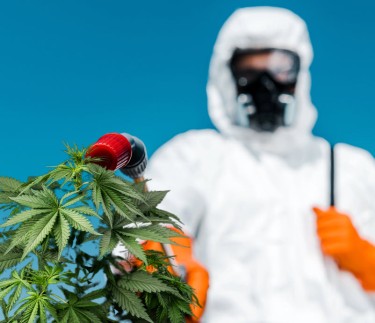Cannabis News
Spray CBD to Control Mosquitoes Instead of Pesticides?
Published
1 day agoon
By
admin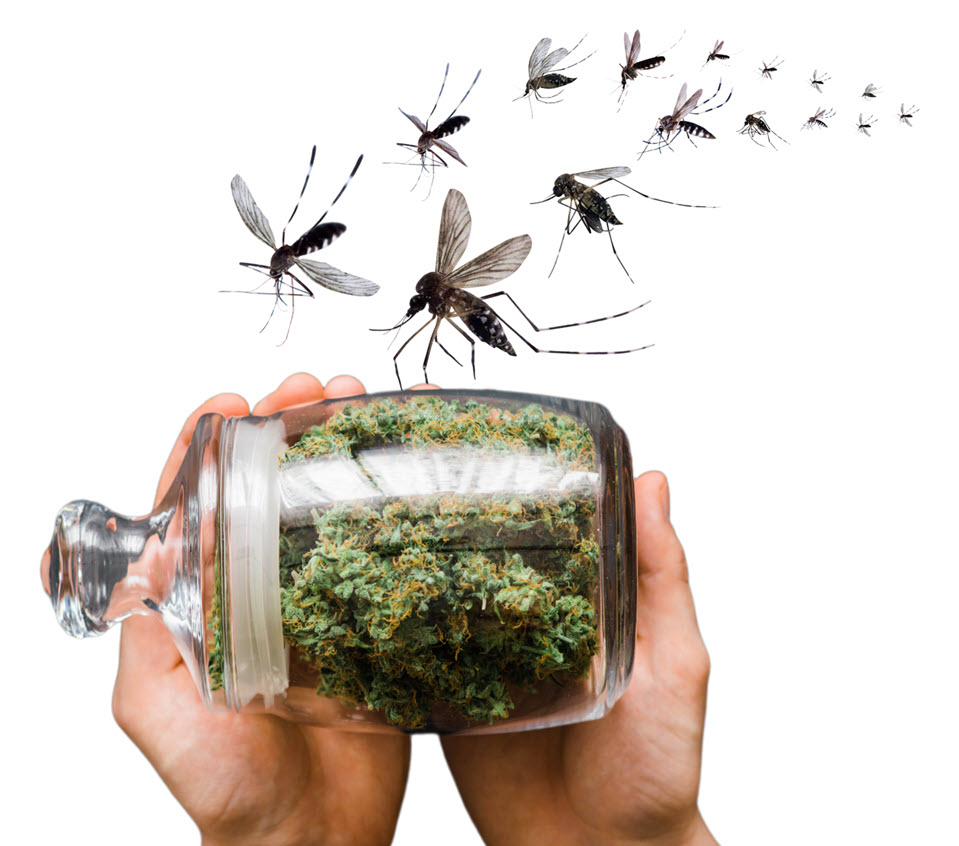
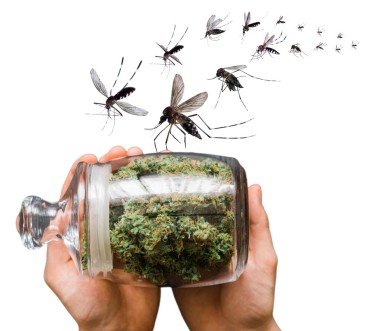
CBD For Pest Control?? New Study Shows CBD Is Effective In Killing Larvae Of Yellow Fever Mosquitoes
Dengue. Chikungunya. Zika virus. Yellow fever. West Nile disease.
If you know what these words mean, you know how much fear these words can incite. All of these words are the names of mosquito-borne diseases that are so dangerous they could be fatal, without early treatment and diagnosis. They can all be transmitted by the yellow fever mosquito, also known as the Aedes aegypti.
Yellow fever mosquitoes can live in any tropical or subtropical, as well as some temperate climates near human residences. There are many ways humans can inhibit the proliferation of these mosquitoes, particularly targeting a reduction or total elimination of eggs and larvae in human dwellings. However, it’s just as important to wear insect repellent too.
Unfortunately, we are yet to find a way to completely eliminate yellow fever mosquitoes. But this may be something that cannabis can help with too. Yes, you read that right: weed!
Cannabidiol (CBD) was recently featured in a publication called Insects documenting a study where hemp-derived CBD was found to be effective in killing yellow fever mosquito larvae. One of these two species studied was resistant to insecticides, yet, the researchers found that using pulverized and air-dried hemp leaves could be used to create a potent methanol concentration. The methanol was eventually removed in order to make it easier to analyze, and it was then fed to the mosquito larvae with its food. Then, it was discovered that the solution could kill these insects in 48 hours.
Erick Martinez Rodriguez, the study’s lead author and an entomology graduate student, told Ohio State News: “Mosquitoes are one of the deadliest animals in the world, mainly because as adults they serve as vectors of disease.”
“If you compare the amount of hemp extract needed to kill 50% of the population to other synthetic conventional insecticides, it is on the high side, but when you compare it side-by-side to other natural extracts we have tested in our lab, only a relatively low amount is required to produce high mortality values in larvae,” Rodriguez disclosed in the interview.
It’s also good to note that hemp is a sustainable crop, so compared to other plant-based insecticides, it could be a good choice and produced economically, adds Rodriguez.
“CBD is a compound that appears to be safe for people and our companion animals to ingest,” explains Peter Piermarini, the study’s co-author and an entomology professor at Ohio State University. “It’ll be interesting to learn more about how CBD interacts with various proteins in mammals and insects to understand why it’s safe for people but not insects,” he added.
Other Studies
This isn’t the first time that cannabis has been studied for its potential applications as an insecticide. According to a recent scientific review from researchers at the Universidade do Sul de Santa Catarina together with investigators at the Universidade Estadual de Sao Paolo in Brazil analyzed the impacts of cannabis on the eggs, larvae, pupae, and even adult vector insects including 4 mosquito species and one type of flea using existing studies.
The researchers said the results revealed the potential insecticidal effects of cannabis in the form of nanoemulsions, extracts, and essential oils. “Different cannabis formulations showed an insecticidal effect on the developmental stages of five species of medically important insects,” read the report. “The larval phase was the most studied; it was approached in all the articles reviews and taking into account all the Cannabis formulation formats,” the authors said.
The findings further cement the fact that cannabis should be explored much further as a natural, safe insecticide especially for targeting dangerous insects that can cause life-threatening disease to humans.
“However, we ought to clarify that despite the reported Cannabis insecticidal action on this insect vectors’ stage of development, there are still few studies that have approached the effect of this plant on the vectors’ larval stage that would allow an effective conclusion considering each formulation,” they wrote.
Meanwhile, researchers have also looked into the potential use of cannabis as a pesticide. Cornell University investigators from the School of Integrative Plant Science (Cornell AgriTech’s College of Agriculture and Life Sciences or CALS) discovered that a high concentration of cannabinoids from hemp leaves may have deterred insects chewing it, compared to other leaves that had less cannabinoids.
According to Larry Smart, a CALS professor and plant breeder, there’s a great lack of studies looking into why cannabis plants evolved to contain over 100 unique cannabinoids. “It has been speculated that they are defensive compounds, because they primarily accumulate in the female flowers to protect seeds, which is a fairly common concept in plants,” Smart explained. “But no one has put together a comprehensive set of experimental results to show a direct relationship between the accumulation of these cannabinoids and their harmful effects on insects,” he said.
When Cornell University began their hemp breeding program in 2017, that’s when the researchers observed a strange phenomenon: hemp from Ukraine, which didn’t produce cannabinoids, were far more vulnerable to being eaten by Japanese beetles. However, other hemp varieties that did produce cannabinoids didn’t have the same results. “In the absence of cannabinoids, we saw heavy insect damage, and in the presence of cannabinoids, we saw much less damage,” Smart said.
Conclusion
While we do need more studies on the subject, it’s clear that this is an angle worth exploring. Cannabis and hemp in general have shown to be effective in killing pests, especially the larvae of mosquitoes that transmit potentially fatal diseases. Aside from being effective, cannabis is also a much more cost-effective and environmentally-friendly solution.
PESTICIDES AND CANNABIS, READ ON…
You may like
-


DEA Causes Another Delay In Marijuana Rescheduling
-


Which states could legalize weed in 2025?
-


Has the Marijuana Industry Hit Rock Bottom?
-


Global Cannabis Spotlight: The Czech Republic’s Psychomodulatory Substances Law
-


DEA cannabis rescheduling hearings canceled by judge (Newsletter: January 14, 2025)
-


Karma Koala Podcast 219: Matt Brockmeier of Antithesis Law.. The New Psychedelics Program In Colorado & Being A Psychedelics Lawyer
Cannabis News
Has the Marijuana Industry Hit Rock Bottom?
Published
6 hours agoon
January 14, 2025By
admin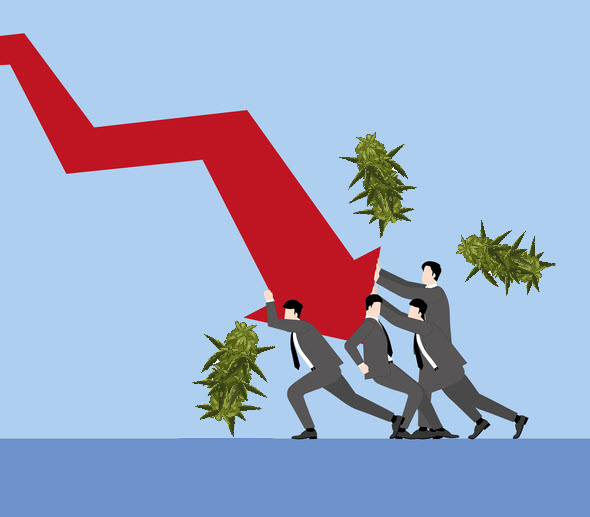
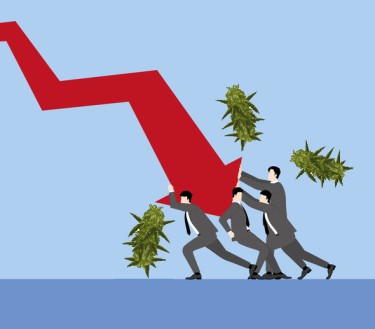
The cannabis industry has undergone a remarkable transformation over the past decade, evolving from a largely illicit market to a burgeoning sector with legal frameworks across numerous states and countries. However, this rapid growth has not come without its challenges. As the market matures, many marijuana businesses are facing financial distress due to various factors, including regulatory hurdles, market saturation, and changing consumer preferences. For savvy investors and entrepreneurs, these distressed businesses present unique opportunities for acquisition and growth. However, navigating this landscape requires caution and a comprehensive understanding of the risks involved.
The Current State of the Marijuana Industry
Market Growth and Challenges
The legal cannabis market in North America has seen exponential growth since the early 2010s. According to industry reports, the U.S. cannabis market was valued at approximately $13 billion in 2020 and is projected to reach $41 billion by 2025. This growth has been fueled by increasing legalization efforts at both state and federal levels, as well as a growing acceptance of cannabis for both medicinal and recreational use.
Despite this promising outlook, the industry faces significant challenges that have led to a wave of distressed businesses. These challenges include:
-
Regulatory Uncertainty: The patchwork of state laws creates confusion and compliance issues for businesses operating across state lines.
-
Market Saturation: In some regions, an influx of new licenses has led to oversupply, driving down prices and squeezing profit margins.
-
Banking Restrictions: Many cannabis businesses operate in cash due to federal banking restrictions, making it difficult to manage finances effectively.
-
High Operational Costs: From cultivation to distribution, the costs associated with running a cannabis business can be prohibitively high.
The Rise of Distressed Businesses
As these challenges mount, many marijuana businesses find themselves in precarious financial positions. Companies that once thrived may now be struggling to meet operational costs or repay debts. This creates a landscape ripe for investors looking for opportunities to acquire distressed assets at favorable prices.
Types of Distressed Businesses
Investors interested in the cannabis sector should be aware of the various types of distressed businesses available for acquisition:
1. Cultivation Facilities: These businesses may have excess inventory or face operational inefficiencies that hinder profitability.
2. Retail Dispensaries: With increased competition, some dispensaries may struggle to attract customers or maintain profitability.
3. Manufacturers: Companies producing cannabis-infused products may face challenges related to supply chain disruptions or regulatory compliance.
4. Ancillary Businesses: Companies providing services or products to the cannabis industry—such as packaging, security, or consulting—may also experience distress if their clients are struggling.
Evaluating Potential Acquisitions
When considering an investment in a distressed marijuana business, it is crucial to conduct thorough due diligence. Here are key factors to evaluate:
-
Balance Sheets: Review financial statements to assess assets, liabilities, and equity.
-
Cash Flow Analysis: Understand cash flow patterns to determine whether the business can sustain operations.
-
Debt Levels: Evaluate existing debt obligations and repayment schedules.
-
Management Team: Assess the experience and track record of the management team in navigating challenges within the cannabis sector.
-
Supply Chain Resilience: Investigate supply chain relationships and potential vulnerabilities.
-
Facility Conditions: Inspect physical locations for compliance with regulations and operational efficiency.
-
Licensing Status: Confirm that all necessary licenses are in place and up-to-date.
-
Legal Issues: Investigate any pending legal matters that could impact operations or financial stability.
-
Compliance History: Review past compliance issues with state regulations that could pose future risks.
Risks Involved
While there are substantial opportunities within distressed marijuana businesses, investors must also be aware of the risks involved:
The cannabis market is still relatively young and can be highly volatile. Prices for cannabis products can fluctuate dramatically based on supply and demand dynamics. Investors should be prepared for potential downturns that could affect profitability.
Changes in legislation can have immediate impacts on business operations. For instance, if a state decides to impose stricter regulations or taxes on cannabis sales, it could significantly affect profit margins.
Distressed businesses often have underlying operational issues that may not be immediately apparent. These could include outdated technology, ineffective marketing strategies, or poor customer service practices.
Investing in a distressed business can carry reputational risks if the company has been associated with legal troubles or poor business practices. It is essential to consider how these factors might affect your brand as an investor.
Strategies for Success
For those willing to navigate the complexities of investing in distressed marijuana businesses, several strategies can enhance the likelihood of success:
A well-defined business plan is essential for guiding operations post-acquisition. This plan should address:
-
Operational Improvements: Identify areas where efficiencies can be gained.
-
Market Positioning: Develop strategies for differentiating from competitors.
-
Financial Projections: Create realistic forecasts based on thorough market analysis.
Assembling an experienced management team with expertise in both cannabis operations and turnaround strategies is critical. This team should possess a deep understanding of regulatory requirements and market dynamics.
Given the regulatory complexities surrounding cannabis businesses, maintaining strict compliance is paramount. Establishing robust compliance protocols can help mitigate legal risks and foster positive relationships with regulators.
Leveraging insights from industry experts can provide valuable perspectives on market trends and operational best practices. Consider forming advisory boards or partnerships with experienced professionals in the cannabis sector.
Staying informed about emerging trends within the cannabis industry is essential for making strategic decisions. This includes keeping an eye on consumer preferences, technological advancements, and shifts in regulatory landscapes.
Case Studies of Successful Turnarounds
To illustrate how investors can successfully navigate distressed marijuana businesses, consider these case studies:
Case Study 1: GreenLeaf Cultivation Co.
GreenLeaf Cultivation Co., once a leading producer of organic cannabis products, faced significant financial difficulties due to oversupply in its region. After being acquired by a private equity firm specializing in distressed assets, GreenLeaf underwent a comprehensive restructuring process.
The new management team focused on streamlining operations by reducing overhead costs and optimizing cultivation techniques. They also rebranded the product line to appeal to health-conscious consumers. Within two years, GreenLeaf returned to profitability and expanded its market presence through strategic partnerships with local dispensaries.
Case Study 2: Urban Buds Dispensary
Urban Buds Dispensary struggled with declining sales amid increasing competition from new entrants in its market. After being acquired by an investor group with experience in retail turnaround strategies, Urban Buds implemented several key changes.
The new owners revamped the store layout to enhance customer experience and introduced loyalty programs to retain existing customers while attracting new ones. They also invested in targeted marketing campaigns highlighting unique product offerings. As a result, Urban Buds saw a 50% increase in sales within one year.
Conclusion
The landscape of distressed marijuana businesses presents both significant opportunities and formidable challenges for investors willing to engage with this complex sector. While potential returns can be substantial for those who navigate these waters wisely, it is crucial to approach such investments with caution. By conducting thorough due diligence, understanding market dynamics, focusing on compliance, and implementing effective turnaround strategies, investors can position themselves for success in this evolving industry. As the legal cannabis market continues to mature, those who are prepared will find that opportunities abound—but only for those who are willing to tread carefully through its intricacies.
WHERE IS THE BOTTOM IN THE CANNABIS INDUSTRY, READ ON…
Cannabis News
Global Cannabis Spotlight: The Czech Republic’s Psychomodulatory Substances Law
Published
7 hours agoon
January 14, 2025By
admin
Last year, I attended an Expert Seminar in Amsterdam on Cannabis Regulation, EU Drug Law, Trade Rules, and the UN Drug Control Treaties. A central topic focused on advancing full cannabis legalization while complying with EU law and international Drug Treaties. During the discussion, Czechia presented its three-pillar approach to cannabis regulation: (1) decriminalization (in 2010, Czechia decriminalized cultivating up to five plants and possessing up to half an ounce of marijuana); (2) regulation of “psychomodulatory substances”; and (3) full commercial regulation. Like Germany, Malta, and Luxembourg, Czechia’s approach relies on scientific evidence. It shows that regulation, rather than prohibition, better protects children and society’s health, safety and welfare.
What is the Psychomodulatory Substances Law?
The law and related rules (effective on July 1, 2025), creates a new category of psychoactive substances with acceptable health risks. The current list includes four substances: low-THC cannabis extracts and tinctures (≤1% THC), kratom, and kratom extract. Other substances, like Hexahydrocannabinol (HHC), could be added if research shows their low health risks after two years. To be included, substances must prove they don’t pose significant public health or societal risks.
HHC faces hurdles in gaining approval. Czechia previously sought to ban HHC products in 2024. Additionally, the global community is still evaluating the substance. Last year, the WHO completed its review of HHC. Many expect the UN Commission on Narcotic Drugs to schedule it under the 1971 Convention. While cannabis is listed under the 1961 Single Convention, “industrial hemp” is excluded. This creates a legal loophole for low-THC hemp programs.
In Czechia, cannabis with less than 1% THC is classified as “technical hemp.” This classification has led to a legal grey area, increasing illicit-market activity. The Psychomodulatory Substances Law aims to curb illicit market influence by providing regulated access through licensed operators. This will help protect children, adolescents and adult consumers.
Once added to the list, psychomodulatory substances can be sold to adults (18+) for human consumption. Retail sales will begin in specialized stores by mid-2025. However, EU food and cosmetic laws prevent these substances from being sold in finished food products or cosmetics. Commercial operators will need permits to ensure compliance with regulations and local municipalities can impose their own usage restrictions.
Regulating instead of prohibiting ensures safer, quality-controlled products. This protects vulnerable groups. The law seeks to balance public health protections with Czechia’s obligations under international drug conventions and EU law. Czechia believes its approach aligns with its international commitments and the EU’s free movement of goods.
Legal regulation
Many hoped for full legalization of commercial cannabis. EU and international law create barriers the Czech government is unwilling to challenge. As more quasi-legal programs emerge across Europe, pressure may build on the EU to adjust its laws, allowing for fully regulated commercial cannabis sales. Until then, scaled-back approaches like Czechia’s psychomodulatory substances law will help fill the gap.
Conclusion
Czechia’s regulatory framework aims to reduce illicit market activity while prioritizing public health and welfare. It is not the first EU country to explore alternatives to full cannabis legalization and it likely won’t be the last. Despite a conservative government, Czechia balances traditional views with evidence that regulation, not prohibition, is the best approach. As seen in the U.S., low-THC legalization can create a robust market. It can also lead to unintended consequences, like unregulated intoxicating hemp products.
Since Czechia’s law does not allow ready-to-eat low-THC products, it remains unclear whether the country will face the same challenges seen elsewhere. While illicit market activity in cannabis extracts and tinctures will likely decrease, demand for ready-to-eat, low-THC products may rise. Until countries regulate the entire supply chain—from seed to sale (including ready-to-eat products and high-THC marijuana)—it will remain difficult to eliminate illicit market influence. Czechia operates within the constraints of EU and international law. This hinders EU members from implementing fully legalized commercial cannabis programs. As a result, the illicit market will continue to fill any gaps left by these limitations.
Cannabis News
Thinking about Suicide, Smoke Some Weed
Published
3 days agoon
January 11, 2025By
admin

The conversation surrounding medical cannabis has gained significant momentum in recent years, especially as more jurisdictions legalize its use for therapeutic purposes. A recent study has added a compelling dimension to this dialogue, revealing that patients who utilize medical cannabis are less likely to experience suicidal thoughts. This finding is particularly pertinent given the rising rates of mental health issues and suicidality across various demographics. This article will explore the study’s methodology, findings, implications for mental health treatment, and the broader context of cannabis use in psychiatric care.
Overview of the Study
Research Design
The study was conducted by a team of researchers interested in understanding the mental health outcomes associated with medical cannabis use. They focused on a cohort of patients who had been prescribed cannabis-based medicinal products (CBMPs) for various medical conditions, including chronic pain, anxiety disorders, and post-traumatic stress disorder (PTSD). The researchers employed a longitudinal design, allowing them to track changes in mental health status over time.
Participants
The study involved a diverse group of participants, including adults from various age groups, genders, and backgrounds. All participants had a documented history of mental health issues and were seeking alternative treatments due to inadequate responses to conventional therapies. The sample size included 500 patients who provided informed consent to participate in the research.
Data Collection
Data were collected through self-reported questionnaires administered at multiple points: before starting medical cannabis treatment and at regular intervals thereafter (e.g., one month, three months, and six months post-initiation). The questionnaires assessed various aspects of mental health, including:
-
Suicidal Ideation: Participants rated the frequency and intensity of any suicidal thoughts they experienced.
-
Depression and Anxiety Symptoms: Standardized scales were used to measure levels of depression and anxiety.
-
Quality of Life: Participants reported on their overall quality of life and well-being.
Reduction in Suicidal Thoughts
One of the most significant findings from the study was that patients who began using medical cannabis reported a marked reduction in suicidal ideation. Specifically:
-
Post-Treatment Outcomes: Within three months of initiating cannabis treatment, this figure dropped to around 10%. By six months, only about 5% reported ongoing suicidal thoughts.
This substantial decline suggests that medical cannabis may have a protective effect against suicidality for certain patients.
Improvement in Mental Health Symptoms
In addition to reduced suicidal thoughts, many participants reported improvements in other mental health symptoms:
-
Anxiety Reduction: Around 70% of participants noted decreased anxiety levels after starting medical cannabis treatment.
-
Depression Alleviation: Approximately 65% reported an improvement in depressive symptoms. These findings align with previous research suggesting that cannabinoids may help alleviate symptoms associated with mood disorders.
Demographic Insights
The study also explored how demographic factors influenced outcomes:
-
Age Variations: Younger adults (ages 18-30) showed more significant reductions in suicidal ideation compared to older adults. This may suggest that younger individuals are more responsive to the therapeutic effects of cannabis.
-
Gender Differences: Female participants reported higher initial levels of suicidal thoughts but experienced similar reductions as their male counterparts following treatment.
Contextualizing the Findings
The Debate on Cannabis and Mental Health
The relationship between cannabis use and mental health has been complex and often contentious. Historically, many studies have highlighted potential risks associated with recreational cannabis use, including increased rates of anxiety, depression, and psychosis. However, this new research emphasizes the potential benefits of medicinal cannabis for patients with severe mental health issues.
Recreational vs. Medicinal Use
It is essential to differentiate between recreational and medicinal cannabis use:
-
Recreational Use Risks: Research has indicated that recreational users may be at higher risk for developing mental health issues. For instance, a study published in *JAMA Psychiatry* found that frequent recreational cannabis users were more likely to report suicidal thoughts compared to non-users.
-
Medicinal Use Benefits: In contrast, medicinal cannabis is often prescribed specifically for its therapeutic properties. The cannabinoids found in medical products—such as THC (tetrahydrocannabinol) and CBD (cannabidiol)—have been shown to have anxiolytic (anxiety-reducing), antidepressant, and neuroprotective effects.
Mechanisms Behind the Effects
While this study provides compelling evidence regarding the benefits of medical cannabis for reducing suicidal thoughts, it also raises questions about the underlying mechanisms at play:
-
Endocannabinoid System: The endocannabinoid system (ECS) plays a crucial role in regulating mood, stress responses, and emotional processing. Cannabinoids interact with ECS receptors (CB1 and CB2), potentially modulating neurotransmitter release related to mood regulation.
-
Pain Management: Chronic pain is often linked with depression and suicidal ideation. By alleviating pain symptoms through medical cannabis use, patients may experience an overall improvement in their quality of life and mental health status.
Implications for Treatment
The findings from this study have several important implications for clinical practice regarding mental health treatment:
Integrating Medical Cannabis into Treatment Plans
Given the promising results regarding reduced suicidality among patients using medical cannabis:
-
Personalized Treatment Approaches: As with any treatment modality, it is crucial for healthcare providers to tailor approaches based on individual patient needs. Medical history, current medications, and personal preferences should all be considered when recommending cannabis as a treatment option.
Need for Further Research
While these findings are encouraging, they also underscore the necessity for further research:
Addressing Concerns About Cannabis Use
Despite the positive findings regarding medical cannabis use in reducing suicidality, it is essential to address potential concerns:
While medicinal use can offer benefits, there is still a risk associated with misuse or dependency on cannabis products:
Stigma Surrounding Cannabis Use
Despite growing acceptance of medical cannabis, stigma remains a barrier for many individuals seeking treatment:
-
Concealment of Use: Many patients feel compelled to hide their cannabis use due to fear of judgment, leading to a lack of open dialogue with healthcare providers, which can hinder effective treatment.
-
Misconceptions and Misinformation: Stigma is often fueled by misconceptions about cannabis, including its association with addiction and recreational use, which can deter patients from seeking necessary medical care.
-
mpact on Mental Health: The stigma associated with cannabis use can contribute to negative mental health outcomes, such as anxiety and depression, as individuals grapple with societal perceptions and internalized shame.
Healthcare providers should foster open conversations about medical cannabis with their patients. Addressing concerns directly can help reduce stigma and encourage individuals to seek appropriate care.
Conclusion
A recent study indicates that patients using medical cannabis experience a significant reduction in suicidal thoughts, underscoring its potential therapeutic benefits amid rising mental health issues. Understanding alternative treatment options is increasingly vital, and while further research is needed to explore the mechanisms and long-term effects, this study supports considering medical cannabis as a viable treatment for severe mental health conditions. By fostering open communication about treatment options and promoting responsible use practices, healthcare providers can better support patients. As societal attitudes toward cannabis evolve alongside scientific understanding, prioritizing comprehensive care for those facing mental health challenges is essential, recognizing medical cannabis’s potential to alleviate suffering and improve well-being.
CANNABIS FOR TEEN SUICIDE RATES, READ ON…

DEA Causes Another Delay In Marijuana Rescheduling

Which states could legalize weed in 2025?

Has the Marijuana Industry Hit Rock Bottom?

Global Cannabis Spotlight: The Czech Republic’s Psychomodulatory Substances Law
DEA cannabis rescheduling hearings canceled by judge (Newsletter: January 14, 2025)

Karma Koala Podcast 219: Matt Brockmeier of Antithesis Law.. The New Psychedelics Program In Colorado & Being A Psychedelics Lawyer

Soap Operas Reflect The Changing Status Of Cannabis

The 12 Best Glue crosses of all time

Dolly Parton Expands Her Food Empire

Spray CBD to Control Mosquitoes Instead of Pesticides?

Distressed Cannabis Business Takeaways – Canna Law Blog™

United States: Alex Malyshev And Melinda Fellner Discuss The Intersection Of Tax And Cannabis In New Video Series – Part VI: Licensing (Video)

What you Need to Know

Drug Testing for Marijuana – The Joint Blog

NCIA Write About Their Equity Scholarship Program

It has been a wild news week – here’s how CBD and weed can help you relax

Cannabis, alcohol firm SNDL loses CA$372.4 million in 2022

A new April 20 cannabis contest includes a $40,000 purse

Your Go-To Source for Cannabis Logos and Designs

UArizona launches online cannabis compliance online course
Trending
-

 Cannabis News2 years ago
Cannabis News2 years agoDistressed Cannabis Business Takeaways – Canna Law Blog™
-

 One-Hit Wonders2 years ago
One-Hit Wonders2 years agoUnited States: Alex Malyshev And Melinda Fellner Discuss The Intersection Of Tax And Cannabis In New Video Series – Part VI: Licensing (Video)
-

 Cannabis 1012 years ago
Cannabis 1012 years agoWhat you Need to Know
-

 drug testing1 year ago
drug testing1 year agoDrug Testing for Marijuana – The Joint Blog
-

 Education2 years ago
Education2 years agoNCIA Write About Their Equity Scholarship Program
-

 Cannabis2 years ago
Cannabis2 years agoIt has been a wild news week – here’s how CBD and weed can help you relax
-

 Marijuana Business Daily2 years ago
Marijuana Business Daily2 years agoCannabis, alcohol firm SNDL loses CA$372.4 million in 2022
-

 California2 years ago
California2 years agoA new April 20 cannabis contest includes a $40,000 purse



